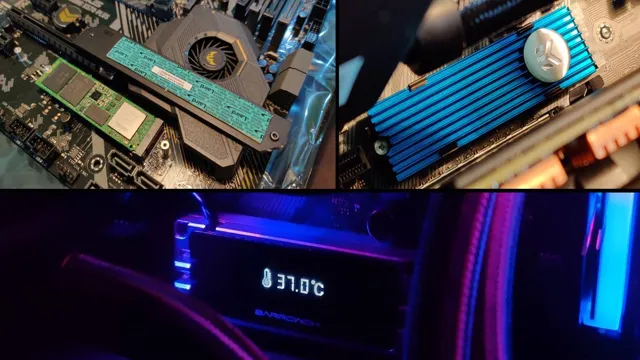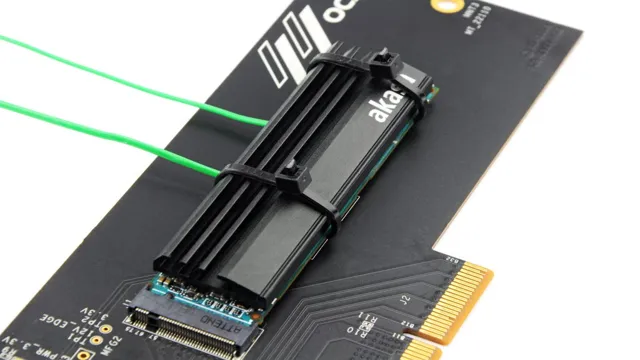Looking for ways to maximize the performance of your M.2 SSD? With their fast read and write speeds, M.2 SSDs are becoming increasingly popular among PC builders and gamers.
However, one question that often arises is whether M.2 SSDs need a heatsink. The short answer is that it depends on various factors, such as your system configuration, the intensity of your workload, and the type of M.
2 SSD you are using. In this blog post, we will discuss the benefits of using a heatsink for M.2 SSDs, as well as the instances where a heatsink might not be necessary.
Whether you are a seasoned PC builder or just starting, it is important to understand the role of heatsinks in optimizing the performance of your M.2 SSD.
Introduction
M.2 SSDs have become increasingly popular in recent years due to their fast read and write speeds. However, many people wonder if they need a heatsink to keep them cool.
The answer, like many things in life, is that it depends. M.2 SSDs generate heat during operation, especially when under heavy loads.
While some SSDs come with built-in heatsinks, not all do. If you’re using your SSD for basic tasks such as web browsing, you probably don’t need a heatsink. However, if you’re using your drive for more intensive applications such as gaming or video editing, a heatsink is recommended to prevent overheating and potential performance issues.
Additionally, installing a heatsink can help prolong the life of your drive, so it’s definitely worth considering if you’re using your M.2 SSD for demanding workloads. Ultimately, it’s up to you to decide whether or not you need a heatsink.
If you’re unsure, consult your SSD manufacturer’s recommendations or talk to a computer hardware professional.
What is M.2 SSD?
M.2 SSD, also known as Next Generation Form Factor (NGFF), is a small form factor solid-state drive used for storage in modern computing devices like laptops and desktops. The M.
2 SSD is designed to replace the aging mSATA storage system, which had become outdated with the advancement of technology. This new type of SSD is significantly smaller in size than traditional hard drives, making it ideal for use in compact machines like mobile devices. Unlike mSATA, M.
2 SSD uses faster communication protocols like SATA and PCIe, allowing for faster data transfer between the storage device and the computer’s CPU. Overall, M.2 SSD provides enhanced performance, faster speed, and improved storage capacity.
With its small form factor and high-performance capabilities, M.2 SSD is a growing choice for tech enthusiasts and professionals alike.

What is a Heatsink?
Heatsink is an essential component in electronic devices that helps dissipate heat and prevent them from overheating. It is a passive cooling device that absorbs and disperses heat generated by electronic components. The heatsink is typically made of materials such as aluminum or copper and consists of fins and a base.
The fins increase the surface area of the heatsink and help in the transfer of heat to the surrounding air, while the base sits on the area where the heat is generated, such as a CPU or GPU, to absorb the heat. Overall, a heatsink plays a crucial role in maintaining the proper functioning of electronic devices, preventing damage, and extending their lifespan.
Performance Impact
One may wonder if they require a heatsink for their M.2 SSDs. The short answer is it depends on usage and the specific SSD model.
On a day-to-day basis, an M.2 SSD running at regular speed may not need a heatsink. However, if you are someone who regularly transfers large files or runs intensive programs, your SSD will run hotter and may require a heatsink.
In some cases, the SSD’s performance can be impacted by a higher temperature, which could lead to slower data transfer speeds and an overall reduction in performance. It’s essential to check your M.2 SSD manufacturer’s suggestions as they may provide guidance on if a heatsink is recommended for your particular SSD model.
Some M.2 SSDs come with built-in heatsinks, while others do not. In the end, it’s up to the user to decide if they require a heatsink to ensure optimal SSD performance.
Importance of Heatsinks for High Performance M.2 SSDs
Heatsinks are an important component when it comes to high performance M.2 SSDs. One of the main benefits of using a heatsink is that it can help to dissipate the heat generated by the SSD, which can prevent it from overheating.
This is particularly important when it comes to high performance SSDs, as they tend to generate more heat than slower drives. Without a heatsink, the heat generated by the drive can cause it to slow down, which can have a significant impact on its overall performance. Additionally, a heatsink can help to reduce the risk of data loss by preventing the components of the drive from becoming too hot, which can cause them to malfunction.
Overall, if you’re looking to get the most out of your high performance M.2 SSD, it’s highly recommended that you invest in a heatsink to help keep it cool and running at peak performance.
Effects of Heat on M.2 SSD Performance
M.2 SSD If you’re a gamer, content creator, or power user, you’ll likely know the importance of speedy storage. M.
2 SSDs, in particular, are incredibly fast, but their performance can be affected by temperature. When an M.2 SSD gets hot, it can throttle, which means its performance will decrease.
This is because the faster an SSD operates, the more heat it generates, and when that heat can’t be dissipated quickly enough, the SSD slows down to protect itself from damage. Unfortunately, this can mean slower load times, decreased transfer speed, and decreased overall performance. Therefore, it’s essential to make sure that your M.
2 SSD stays cool in order to maintain peak performance. One easy way to keep your M.2 SSD at an optimal temperature is by using an M.
2 SSD heatsink. By dissipating the excess heat from your M.2 SSD, you can ensure that it operates at its best.
Overall, the effects of heat on an M.2 SSD can be detrimental to its performance, but taking precautions to keep it cool can help overcome this issue and ensure that your system runs smoothly.
Real-life Examples of Heatsinks Improving M.2 SSD Performance
M.2 SSD When it comes to improving the performance of M.2 SSDs, heatsinks play an essential role.
The addition of a heatsink to an M.2 SSD can help dissipate the heat generated by the drive during operation, preventing thermal throttling. Real-life examples have shown that heatsinks can significantly boost the performance of M.
2 SSDs. For instance, in a test conducted by TechPowerUp, adding a heatsink to a Samsung 960 EVO SSD led to a 13% performance improvement. Similarly, when Corsair tested its MP510 SSD with and without a heatsink, it found that the heatsink reduced the drive’s operating temperatures by up to 20°C, resulting in increased performance.
These examples demonstrate that adding a heatsink to an M.2 SSD can enhance its performance and prevent throttling caused by high temperatures. Therefore, if you want to maximize the performance of your M.
2 SSD, consider investing in a heatsink to keep it cool and running optimally.
Compatibility and Installation
M.2 SSDs often run hot due to their small size and fast speeds, making it a common question among users whether they need a heatsink or not. The answer to this question depends on how you’re using your drive.
If you’re using it for regular day-to-day activities like browsing the internet or word processing, you probably won’t need one. However, if you’re using it for more demanding tasks such as gaming or video editing, a heatsink can help prevent your drive from overheating and potentially causing damage. Additionally, if your computer has limited airflow or is in a warm environment, a heatsink could also benefit your drive.
Ultimately, it’s up to you to decide whether a heatsink is necessary for your particular usage. However, keep in mind that not all M.2 SSDs require heatsinks and some already come with built-in thermal protection, so it’s important to do your research before making a purchase.
Compatibility of Heatsinks with M.2 SSDs
M.2 SSDs, Heatsinks, Compatibility Installing an M.2 SSD can be an excellent way to boost the storage capacity and performance of your system.
However, with the increased speed and power comes additional heat, leading to potential thermal throttling. That’s where heatsinks come in, and the good news is that the majority of M.2 SSDs are compatible with heatsinks.
These heatsinks are designed to fit specific SSD sizes, so it’s crucial to choose the right size for your drive. Installing a heatsink onto your M.2 SSD can be done reasonably easily, as most heatsinks come with some form of thermal adhesive or tape.
Simply ensure that the SSD is clean and free of debris before applying the heatsink. By combining a heatsink with your M.2 SSD, you can keep your storage running efficiently and reduce the risk of thermal throttling, making it an excellent investment for any system.
Installation Process of Heatsinks on M.2 SSDs
When it comes to installing heatsinks on M.2 SSDs, compatibility is crucial. It’s important to make sure that the heatsink you choose is compatible with your specific M.
2 SSD model. Some heatsinks only work with certain SSD sizes, so double-checking the size of your SSD is also important. Once you’ve confirmed compatibility, the installation process can vary depending on the heatsink you choose.
Some heatsinks come with adhesive strips to attach directly to the SSD, while others require screws and a mounting bracket. It’s important to follow the manufacturer’s instructions carefully to ensure proper installation and avoid damaging your SSD. Overall, installing a heatsink on your M.
2 SSD can improve its performance by reducing heat buildup and prolonging its lifespan.
Conclusion
In conclusion, the question of whether M.2 SSDs need a heatsink can be answered with a resounding “it depends.” While some may argue that the heat generated by these tiny components is negligible, others point out that consistent high temperatures can lead to reduced performance and even premature failure.
Ultimately, the decision to invest in a heatsink for your M.2 SSD should take into account your specific usage patterns and desired performance outcomes. So, weigh your options carefully and remember: when it comes to tech, cooling down can often lead to heating up in all the right ways.
“
FAQs
What is an M.2 SSD?
M.2 SSD is a solid-state drive that uses the M.2 form factor for connecting it to the motherboard.
Do all M.2 SSDs need a heatsink?
No, not all M.2 SSDs need a heatsink. It depends on the SSD’s type of NAND flash memory and the workload it is expected to handle.
How does a heatsink benefit an M.2 SSD?
A heatsink helps to cool down the temperature of the M.2 SSD by dissipating the heat generated during the heavy workload. It also helps to maintain the performance and prolong the lifespan of the SSD.
What are the types of heatsinks available for M.2 SSDs?
There are mainly two types of heatsinks available for M.2 SSDs – passive and active heatsinks. Passive heatsinks use a metal plate or finned design to dissipate heat, while active heatsinks use fans to cool down the temperature of the SSD.
